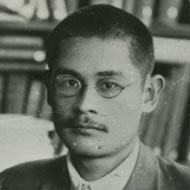| Matsumoto Hikoshichirō 松本彦七郎 | |
|---|---|
 | |
| Born | 9 June 1887 |
| Died | 1 September 1975 (aged 82) |
| Nationality | Japanese |
| Known for | Palaeontology |
Matsumoto Hikoshichirō (松本彦七郎) (1887–1975) was a Japanese zoologist, palaeontologist, and archaeologist, and a recipient of the Imperial Academy Prize.
Biography
Born in Meiji 20 (1887), Matsumoto graduated from the Department of Zoology, Tokyo Imperial University, in 1911. From 1914 to 1933 he taught at Tohoku Imperial University, initially as a lecturer, then from 1922 as professor. From 1955, he was professor of biology at Fukushima Medical University, where he taught basic medicine. In 1921, he was awarded the Imperial Academy Prize in recognition of his work on brittle stars (Ophiuroidea). His contributions to the field of vertebrate palaeontology include descriptions of the Akebono elephant (Stegodon aurorae) and Hanaizumi bison (Bison hanaizumiensis), while as an archaeologist he helped develop typologies of Jōmon ceramics. Matsumoto died in 1975.
References
- ^ 松本彦七郎博士 研究略歴 [Dr. Matsumoto Hikoshichirō: Research Biography] (in Japanese). The University Museum, The University of Tokyo. Retrieved 14 June 2022.
- ^ 松本彦七郎 [Matsumoto Hikoshichirō] (in Japanese). Tōhoku University Museum. Retrieved 14 June 2022.
- ^ 第11回 (大正10年) ~ 第20回 (昭和5年) [11–20th Awards (1921–1930)] (in Japanese). Japan Academy. Retrieved 14 June 2022.